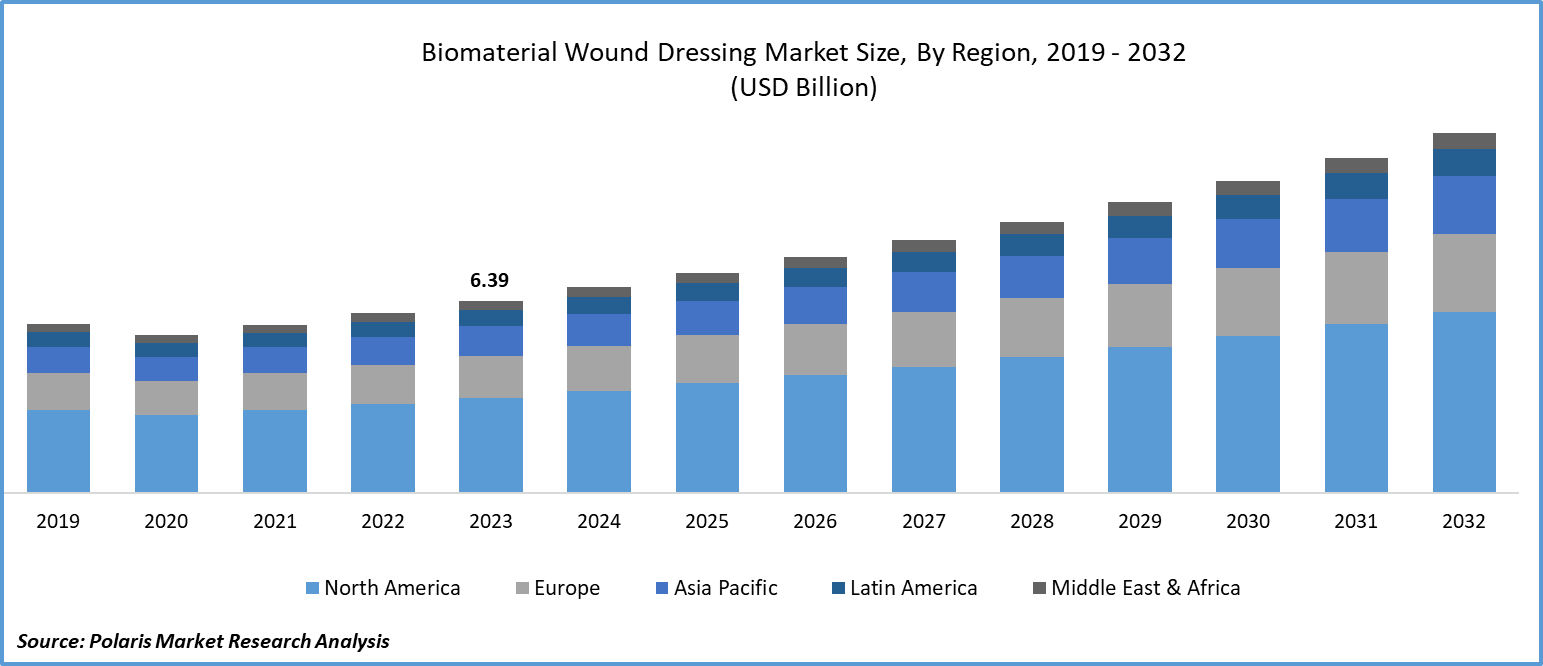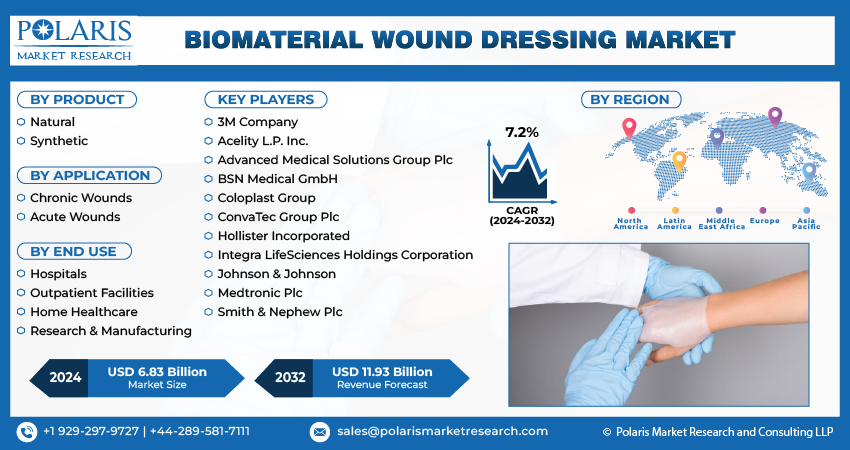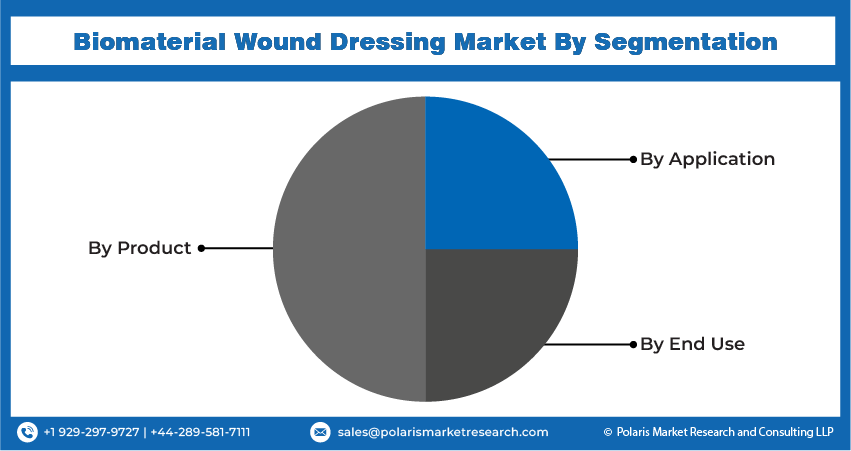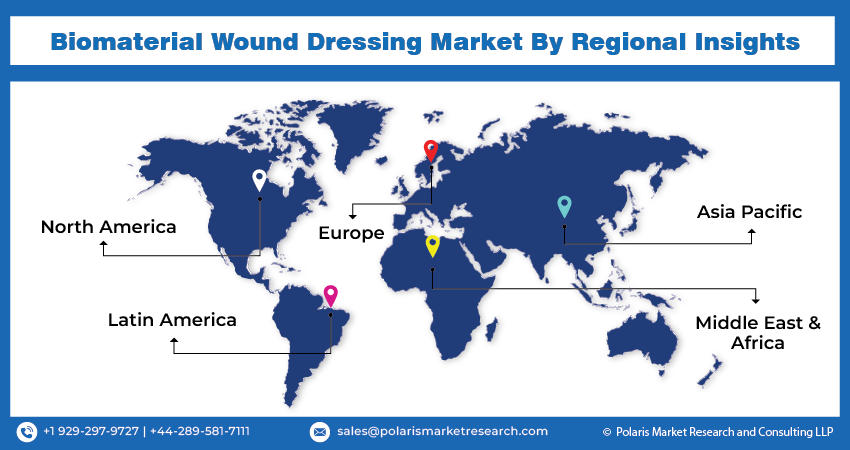
Biomaterial Wound Dressing Market Share, Size, Trends, Industry Analysis Report, By Product (Natural and Synthetic); By Application; By End Use; By Region; Segment Forecast, 2024 - 2032
- Published Date:Apr-2024
- Pages: 119
- Format: PDF
- Report ID: PM4883
- Base Year: 2023
- Historical Data: 2019-2022
Report Outlook
Biomaterial wound dressing market was valued at USD 6.39 billion in 2023. It is anticipated to grow from USD 6.83 billion in 2024 to USD 11.93 billion by 2032, exhibiting a CAGR of 7.2% during the forecast period.
Market Overview
The rising incidence of chronic disorders, increasing elderly population, innovations or advancements in wound care products, and a growing number of favorable government initiatives for wound care products and technologies are major factors driving the market’s growth. Some patients may face difficulties in the healing process of their wound, owing to its nature or severeness. Companies are looking to incorporate specified biomaterials in wound care products as they act as scaffolds for skin regeneration and when applied, it enables the upregulation of distinct molecular signaling pathways that are crucial for skin repair.
There have been several advancements and modifications in biomaterials to develop scaffolds that are highly efficient in promoting cell growth and tissue regeneration. In addition, innovations in novel materials like 3-D printed hydrogels are also gaining traction and allowing companies to develop effective and efficient strategies for wound dressings. Besides this, researchers worldwide are exploring new ways to harness the regenerative properties of stem cells and their use to replace or repair damaged tissues, which will positively impact the market’s growth.

To Understand More About this Research:Request a Free Sample Report
Biomaterials are mainly designed to function in a biological environment that may or may not be developed from biological material. Thus, they are well-suited to be used in tissue restoration or engineering and to replace defective or damaged tissues. Additionally, therapeutic products are expensive and time-consuming to develop or test; thereby, developments in molecular biology, like next-generation sequencing, are gaining traction and pushing tissue engineering forward.
Growth Factors
Rising prevalence of chronic wounds worldwide to drive biomaterial wound dressing market growth
The growing incidence of chronic wounds such as venous ulcers, arterial ulcers, diabetic ulcers, and pressure ulcers is a key factor fostering the demand for the market due to their beneficial characteristics in wound management, such as contamination prevention and enhanced cell migration. For instance, according to the American College of Surgeons, more than 6.5 million people are affected with chronic wounds in the United States, and the prevalence of chronic wounds is projected to increase substantially over the coming years.
Development of advanced wound therapies to drive the biomaterial wound dressing market
There are several advanced wound therapies, including anti-scarring and healing-promoting therapies for surgical wounds, being developed or in the clinical development phase. In addition, a fibromodulin-based amino acid that was found to stimulate fibroblast and endothelial cell migration is gaining traction due to its ability to promote timely wound closure. Various other peptides, including connexin43 and Granexin, which are found in wound edges and also in the dermis, are being used to improve wound closure rate and reduce scarring.
Restraining Factors
Stringent regulations and challenges to hamper biomaterial wound dressing market growth
Biomaterial wound dressings need to comply with stringent requirements to be introduced into the market, which makes the process complex and creates significant challenges for companies. Regulatory bodies are imposing new rules and regulations for certain types of wound dressings and wound washes that contain antimicrobials and other chemicals. For instance, in November 2023, the Food and Drug Administration proposed a new rule for reclassifying certain types of wound dressings containing antimicrobials and chemicals. The new rule can alter various existing wound care products in the market and pose significant aspects of the product lifecycle.

Report Segmentation
The market is primarily segmented based on product, application, end-use, and region.
|
By Product |
By Application |
By End Use |
By Region |
|
|
|
|
To Understand the Scope of this Report:Speak to Analyst
By Product Insights
The natural segment captured the largest biomaterial wound dressing market share in 2023
The natural segment captured the largest share. This dominance is attributed to the widespread adoption of natural dressing products over others due to increased awareness among users regarding the concerns related to synthetic ingredients. Moreover, natural biomaterials like alginate and honey are widely used as biomaterials in different shapes. Due to their homeostatic characteristics, they are also employed as wound dressings with drug release.
The synthetic segment is expected to grow at the highest growth. Segment’s growth is driven by the growing use of synthetic wound dressings on several types of wounds like burns and ulcers while preventing bacteria and other contaminants. Furthermore, synthetic wound dressings are affordable and cost-effective as compared to natural wound dressings due to their simple and less complex manufacturing process, which leads to their greater adoption among both healthcare professionals and patients.
By Application Insights
The chronic wounds segment accounted for a noteworthy biomaterial wound dressing market share in 2023
The chronic wounds segment accounted for a noteworthy share. Segment’s dominance is fueled by a drastic increase in the incidences of chronic wounds such as diabetic foot ulcers and pressure ulcers, coupled with the rising popularity of innovative wound care product offerings, faster healing, and reduced treatment duration. According to the American Diabetes Association, in December 2022, about 19 to 34 percent of people with diabetes across the globe are projected to develop diabetic foot ulcers in their lifetime.
By End Use Insights
The home healthcare segment is expected to witness the fastest biomaterial wound dressing market growth.
The home healthcare segment is expected to grow at the fastest growth rate. This growth is attributable to the increasing number of patients seeking affordable, cost-effective, and convenient wound care solutions due to the high costs of wound dressings in hospitals and other healthcare settings. Additionally, the increasing aging population worldwide who are more likely to require home-based healthcare solutions, including wound care, further contributing to the segment’s growth. For instance, according to a report published by the World Bank in October 2022, the world’s population aged 60 years and above is expected to double its current size and reach 2.1 billion by 2050 from 1 billion in 2020.

Regional Insights
North America dominated the global market in 2023
The North American region dominated the global market in 2023. Region’s dominance is driven larger presence of the elderly population and the growing prevalence of chronic disorders because of significant changes in people's lifestyles. Increasing awareness among people regarding the benefits associated with biomaterial wound dressings and the robust presence of favorable reimbursement policies for wound care that led to greater adoption of the product are some other factors propelling the market growth. For instance, as per the Centers for Disease Control & Prevention (CDC), 6 in every ten adults in the U.S. suffers from chronic disease, and 4 in every 10 have two or more diseases due to poor nutrition, less physical activity, and growing alcohol use.
The Asia Pacific region is anticipated to emerge as the fastest growing region with a healthy CAGR, owing to increasing healthcare expenditure, especially in developing nations like India, China, and South Korea, the region’s growing aging population, and growing awareness or knowledge among the general population regarding the potential benefits associated with the use of wound care. For instance, in September 2023, the number of people aged 60 years or above in India stood at 149 million in 2022, and the number is projected to reach 227 million by 2036.

Key Market Players & Competitive Insights
New product developments and technological advancements to drive competition
The biomaterial wound dressing market needs to be more cohesive. Companies are competing on innovations in natural biomaterials that improve outcomes and patient comfort with few side effects.
Some of the major players operating in the global market include:
- 3M Company
- Acelity L.P. Inc.
- Advanced Medical Solutions Group Plc
- BSN Medical GmbH
- Coloplast Group
- ConvaTec Group Plc
- Hollister Incorporated
- Integra LifeSciences Holdings Corporation
- Johnson & Johnson
- Medtronic Plc
- Smith & Nephew Plc
Recent Developments in the Industry
- In June 2022, Collagen Matrix announced that it had received 510(k) clearance from the US Food and Drug Administration for its new Fibrillar Collagen Wound Dressing. It will be mainly used to treat wounds that exude fluid moderately to extensively and also help control mild bleeding.
Report Coverage
The biomaterial wound dressing market report emphasizes key regions across the globe to provide users with a better understanding of the product. The report also provides market insights into recent developments and trends and analyzes the technologies that are gaining traction around the globe. Furthermore, the report covers an in-depth qualitative analysis pertaining to various paradigm shifts associated with the transformation of these solutions.
The report provides a detailed analysis of the market while focusing on various key aspects such as competitive analysis, product, application, end-user, and their futuristic growth opportunities.
Biomaterial Wound Dressing Market Report Scope
|
Report Attributes |
Details |
|
Market size value in 2024 |
USD 6.83 billion |
|
Revenue Forecast in 2032 |
USD 11.93 billion |
|
CAGR |
7.2% from 2024 – 2032 |
|
Base year |
2023 |
|
Historical data |
2019 – 2022 |
|
Forecast period |
2024 – 2032 |
|
Quantitative units |
Revenue in USD billion and CAGR from 2024 to 2032 |
|
Segments Covered |
|
|
Regional scope |
|
|
Competitive Landscape |
|
|
Report Format |
|
|
Customization |
Report customization as per your requirements with respect to countries, regions, and segmentation. |
FAQ's
The Biomaterial Wound Dressing Market report covering key segments are product, application, end-use, and region.
Biomaterial Wound Dressing Market Size Worth $11.93 Billion By 2032.
Biomaterial wound dressing market exhibiting a CAGR of 7.2% during the forecast period.
North America is leading the global market
key driving factors in Biomaterial Wound Dressing Market are Rising prevalence of chronic wounds worldwide
